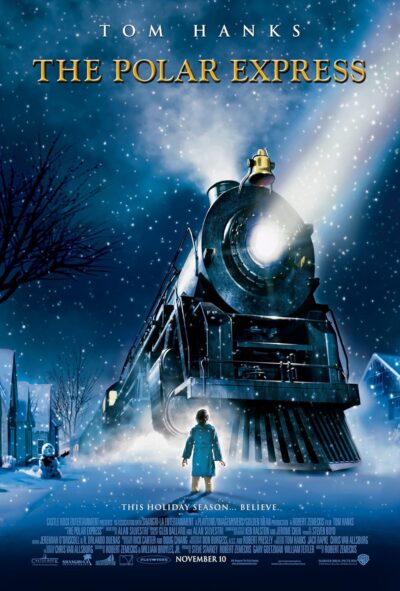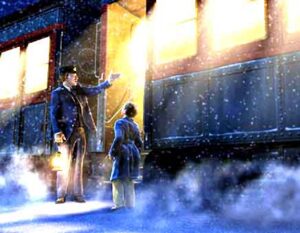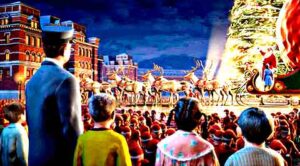This 2004 movie has problems, but it’s still the most interesting entry in director Robert Zemeckis’ post-2000 filmography. THE POLAR EXPRESS was a $170 million undertaking that utilized motion capture animation, in which actors’ motions are recorded into a computer and then transmuted to animation. I wish I could report that the process was a triumphant success, but that just wasn’t the case; motion capture was in its infancy in ‘04 and the growing pains are all-too evident (particularly from a twenty year distance). The film is nonetheless superior to Zemeckis’ subsequent motion capture features BEOWULF (2007) and A CHRISTMAS CAROL (2009).
THE POLAR EXPRESS had its inception in 1985, as a 31-page kid’s book written and illustrated by Chris van Allsburg. About a boy who on Christmas Eve boards a train that takes him to the North Pole, where Santa gives him a bell off his sleigh, the book has been praised for its “calm, relaxing storyline.” In adapting the story to film Zemeckis, who co-scripted, went the opposite route, creating a cacophonous spectacle that played to his strengths as a filmmaker. Van Allsburg’s minimalist storytelling allowed for conceptual excess in line with Zemeckis’ screenplay collaborations with Bob Gale—I WANNA HOLD YOUR HAND (1978), 1941 (1979), USED CARS (1980), BACK TO THE FUTURE (1985) and TRESPASS (1992)—which all took simple premises and subjected them to every conceivable elaboration.
As in the book, the film begins on Christmas Eve, with a young boy (Tom Hanks), identified as “Hero Boy,” pondering the imminent arrival of Santa Claus—whose existence Hero Boy questions because, among other things, the North Pole is said to be devoid of life. Then the Polar Express arrives, announced via a lot of noise and shaking of the house. Hero Boy is ushered onboard by a conductor (Tom Hanks again) and meets several other pajama clad kids, including “Hero Girl” (Nona Gaye), “Know-It-All” (Eddie Deezen) and “Lonely Boy” (Peter Scolari).
Hero Girl’s ticket gets lost, forcing Hero Boy to go to great lengths to retrieve it. In so doing he meets “Hobo” (Hanks again), a stowaway whose precise import to the plot is never made clear. Further disasters take the form of a herd of bison blocking the train, mischief by the goofball engineers “Smokey” and “Steamer” (both played by Michael Jeter), twisty rollercoaster-esque tracks and a lake covered with unstable ice.
Upon reaching the North Pole, depicted as an oddly deserted urban environ in which Santa’s ministrations are carried out in a highly mechanized fashion, Hero Boy accidentally causes the train car in which he, Hero Girl and Lonely Boy are situated to become uncoupled and roll downhill. They end up inside Santa’s toy sack, in which they make their way to the side of Santa Claus (Hanks yet again), surrounded by hundreds of cheering elves and an elf singer (Steven Tyler).
The early scenes are quite strong, with Zemeckis’ flair for action and suspense put to excellent use and some sharp character turns by Hanks (who fares best as the stern conductor) and longtime Zemeckis favorite Eddie Deezen (with the lame music numbers, a kid movie mainstay, being the only major drawback). The North Pole set final third is less successful, as the place looks downright unhospitable, while Santa himself is far too stern and imperious for his own good, being announced by a vast procession right out of TRIUMPH OF THE WILL (1935).
That latter point beings up a rather large problem: the film is packed, consciously or unconsciously, with Nazi imagery. That’s particularly true of the forbidding Auschwitz-like North Pole setting, to which the protagonists are transported by train.
But let’s get back to the animation, which remains the single biggest drawback. Touted as a revolutionary innovation in 2004, the motion capture imagery is impressive in its fluidity and ability to flawlessly render grown adults as children (as happens here with Tom Hanks and his 1980s sitcom cohort Peter Scolari). What it doesn’t capture are eyes, as is painfully evident in the creepy doll-like orbs (which rarely ever match the surrounding faces in feature or expression) sported by the characters in THE POLAR EXPRESS. A horror movie this nocturnal set film isn’t, but it is plenty scary.
Vital Statistics
THE POLAR EXPRESS
Castle Rock Entertainment
Director: Robert Zemeckis
Producers: Steve Starkey, Robert Zemeckis, Gary Goetzman, William Teitler
Screenplay: Robert Zemeckis, William Broyles, Jr.
(Based on a book by Chris van Allsburg)
Cinematography: Don Burgess, Robert Presley
Editing: Jeremiah O’Driscoll, R. Orlando Duenas
Cast: Tom Hanks, Michael Jeter, Nona Gaye, Peter Scolari, Eddie Deezen, Leslie Zemeckis, Steven Tyler, Julene Renee, Chris Coppola, Charles Fleischer




